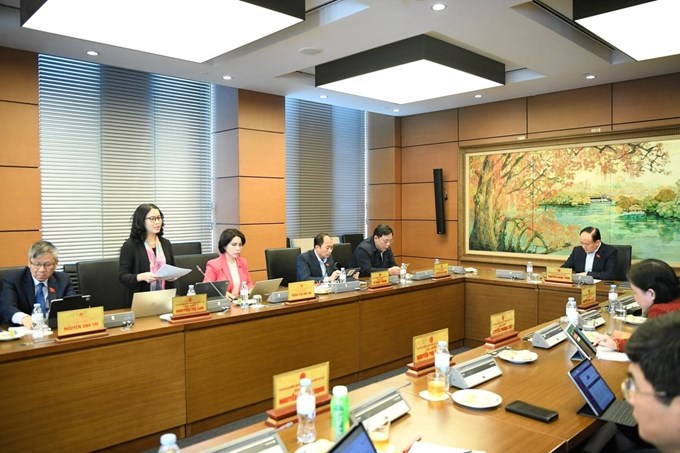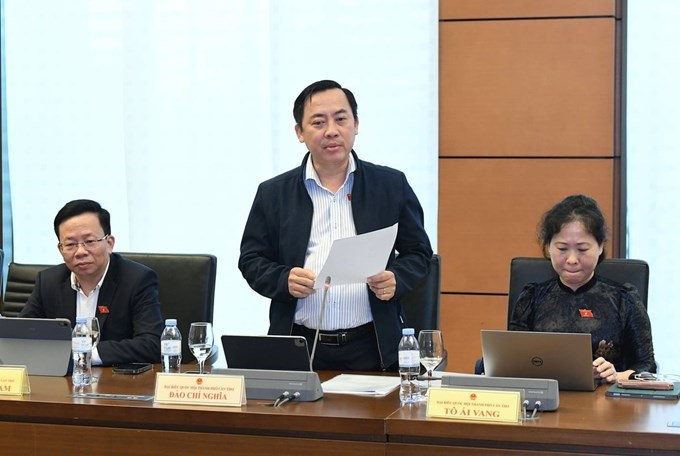National Assembly deputies expected that the completed Law on Artificial Intelligence (AI) would promote innovation, develop high-quality human resources, and expand the application space of AI for socio-economic development.
During the discussion session on the draft Law on Artificial Intelligence, Prof. Dr. Nguyen Thi Lan, National Assembly Deputy (Hanoi Delegation), highly appreciated the drafting committee’s efforts in developing a “well-constructed, modern draft law that clearly reflects innovative thinking.” She emphasized that the AI Law was a pioneering legal framework and would be decisive for the nation’s competitiveness in the coming decades.
In the context of strong global investment in AI, Prof. Dr. Nguyen Thi Lan stressed that enacting the law at this time was “extremely urgent” to ensure that Vietnam did not fall behind and could proactively seize the opportunities brought by emerging technologies.

Prof. Dr. Nguyen Thi Lan emphasized that the AI Law is a pioneering framework that will be decisive for national competitiveness in the coming decades. Photo: Quochoi.vn
The draft demonstrated a progressive orientation that included risk-based governance; development of infrastructure, data, and testing environments; strong emphasis on ethics and accountability; and especially, a comprehensive, internationally aligned policy on AI human-resource development.
Drawing from practical experience in higher education, research, and innovation, Prof. Dr. Nguyen Thi Lan proposed three key groups of recommendations as follows.
Unlocking the AI workforced bottleneck: Grant universities greater autonomy
Commenting on Article 24 and Article 1 of the draft, the President of Vietnam National University of Agriculture (VNUA) noted that although the draft already included orientations for AI workforce development, it still left unresolved three major “bottlenecks” in higher education, including: (i) Procedures for opening new academic programs remained slow, while AI evolved at an extremely rapid pace; (ii) Universities lacked special mechanisms to attract international experts; and (iii) There were insufficient policies to strengthen and expand the AI faculty workforce.
Additionally, Article 1 excluded “AI used for research and training” from the scope of the law but did not clarify what constitutes “internal use.” According to her, without a clearer explanation, authorities might interpret the provision rigidly, creating unintended barriers to university–enterprise collaboration, which was essential for developing high-quality AI workforce.
She recommended adding special mechanisms for higher education, such as granting universities autonomy to open new academic programs, policies to attract international experts, and establishing faculty-development programs in AI, data science, and automation. At the same time, she emphasized the need to clearly define the scope of “AI for research and training purposes” to ensure an open academic environment.
According to Prof. Dr. Nguyen Thi Lan, experiences from Singapore, South Korea, and Israel showed that where universities were given strong authority and industry collaboration was encouraged, AI human resources grew rapidly and sustainably. Vietnam’s own practice also demonstrated this.
Refining the controlled testing mechanism (sandbox): Clear subjects, clear responsibilities
Assessing the inclusion of a sandbox mechanism in Article 22, Deputy Nguyen Thi Lan noted that the current provisions remained “rather general.” The draft did not clearly specify eligible entities permitted to participate, selection criteria for pilot models, duration of pilots, legal responsibilities when risks occur, or data-protection mechanisms.
“If these principles are not clarified directly in the law, the sandbox may be implemented only superficially or applied too cautiously, which would hinder innovation,” she emphasized.
She proposed that the law should outline a clear framework specifying types of AI permitted for testing, rights and obligations of participants (universities, research institutes, and startups, etc.), pilot duration, risk-assessment criteria, and compensation mechanisms. Technical processes could be delegated to the Government for detailed guidance to ensure flexibility.
Lessons from Singapore, the UK, and the EU showed that sandboxes were effective only when legally defined with transparency, helping shorten deployment time for new technologies by 50-70%. Vietnam currently lacks AI testing environments in agriculture, healthcare, education, transportation, and smart-city development. “Completing Article 22 will pave the way for a new generation of AI models,” she stated.

The President of Vietnam National University of Agriculture (VNUA) Prof. Dr. Nguyen Thi Lan stated, “Where universities are empowered and enterprise collaboration is strengthened, AI human resources develop rapidly and sustainably. Vietnam’s reality also confirms this.” Photo: Quochoi.vn
Regarding Article 20, Prof. Dr. Lan agreed with the general direction of developing technology, infrastructure, data, and human resources. However, she argued that the draft remained too general and did not identify strategic priorities, key factors determining feasibility.
She recommended that the law needed to clearly define priority sectors, such as Agriculture, Healthcare, Education, Environment, and Public governance. Additionally, the law should set principles for selecting priority areas and assign responsibilities to specific ministries and agencies. This would help to prevent fragmentation and ensure strategic investment.
According to Prof. Dr. Nguyen Thi Lan, international experience showed that an effective AI strategy had to have clear priorities and transparent monitoring mechanisms. AI applications in agriculture, healthcare, and education in Vietnam, if properly invested in, could generate highly scalable impact.
The AI law must achieve both goals: Governance and development
Meanwhile, in Group 11 (Can Tho and Dien Bien National Assembly Delegations), deputies strongly supported the enactment of the AI Law, though some expressed concerns about the level of detail of the draft law.
Deputy To Ai Vang (Can Tho) affirmed that the law was “essential” to achieving major goals set by the Party’s Resolutions: maintaining Vietnam’s top-3 ASEAN ranking in innovation; ensuring the digital economy accounting for 20% of GDP; positioning Vietnam among ASEAN’s top three in AI; developing at least five world-class digital-technology enterprises; and mastering several strategic technologies.
She emphasized that the law had to provide a legal framework aligned with international norms, facilitating integration and effective domestic application of AI. Deputy Dao Chi Nghia (Can Tho) agreed that the draft was “essential” and should be passed in this session.

Deputy Dao Chi Nghia (Can Tho) speaks during the session. Photo: Lam Hien.
However, Deputy Lo Thi Luyen (Dien Bien) argued that the draft’s governance objectives were “not sufficiently comprehensive,” while its development objectives remained “qualitative and lacking specificity.” She illustrated with the example of the provision on the AI Development Fund, specifically: the draft mentioned establishing a fund from public and socialized sources but did not clarify financial mechanisms or resource allocation.
Deputy Nguyen Tuan Anh (Can Tho) also noted that the draft’s “balanced approach” between regulation and development was not yet explicit. He believed that governance and development were not opposing goals; effective regulation formed the foundation for sustainable development, and different sectors and risk categories required differentiated flexibility.
The deputies expressed the hope that once refined, the AI Law would become a robust legal framework promoting innovation, developing high-quality human resources, and expanding AI applications for socio-economic development, while ensuring security and improving citizens’ quality of life. The Law had to fulfill both goals, namely effective governance and strong development.